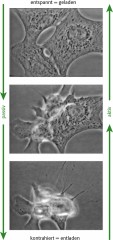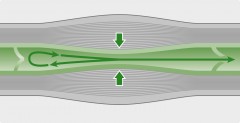

The Scientific Principles of Matrix Rhythm Therapy

Living systems never have rigidly fixed frequencies, but only frequency regions. This variability permits the system to constantly adjust and adapt itself – an ability which is vital to the survival of the organism.
Rhythmic actions such as the heartbeat or brain waves for example, act on living processes like the director of an orchestra. These rhythms are coupled to directed motions of the fluid which surrounds the individual cells. Healthy tissues are characterized by certain specific frequencies of the rhythms which organize their internal processes.
The heart muscle and skeletal musculature are the main rhythmic “clocks” for warm-blooded organisms. They maintain the arterial, venous and lymphatic circulation.

Cells in the extracellular matrix live like fish in water. They depend on the quality and state of the fluid surrounding them.
When body-organizing rhythms depart from their healthy frequency ranges for a prolonged period, this causes a degradation in the quality of the medium surrounding the cells. If the medium becomes chronically “acidic” then the metabolism of the cells is weakened more and more.
Everyone is familiar with phenomenon of trembling or shivering of muscles in extreme situations of cold, fever or anxiety. But research has shown that a healthy skeletal musculature constantly vibrates with a characteristic frequency and amplitude spectrum. This vibration continues during the entire life of the organism, even when the body is in a resting state (so-called physiological tremor, Rohracher microvibrations).
The synchronized vibrations of the muscle fibers in the musculoskeletal system generate a “suction/pumping” effect which supports the work of the heart and plays a decisive role in maintaining an adequate supply of oxygen and nutrients to all the cells in connective tissue, especially on the microscopic level (extracellular matrix).

Pulsating muscle cells depolarize and contract under stress.
Every living system exists in constantly alternating phases of tension and relaxation. In the case of the muscles of the musculoskeletal system, contraction and relaxation can be triggered in a willful, voluntary way. Nevertheless, insufficient energy supply to muscle tissue can lead to a situation in which contraction residues and adhesions persist despite willful efforts to relax the muscles. The person is no longer able to voluntarily release them. The muscle tissue hardens. In order to achieve a state of complete relaxation, external intervention is required – intervention directed at stimulating the metabolism and restoring the logistics of the cells. External intervention to bring about full relaxation of muscles is thus the key to effective therapy.
While classical medicine has up to now concentrated its main attention on structural changes — especially in diagnosis –, process-oriented biomedicine focuses on intervening in a rhythmical manner on the level of the cell and the extracellular matrix.

From the physiological tremor all the way to macroscopic trembling, the musculature vibrates with varying degrees of synchronicity, thereby insuring the physiologically necessary level of blood flow and lymph drainage.
Applied in a systematic way, this basic idea led to the development of Matrix Rhythm Therapy (MaRhyThe) as a process-optimizing therapy which can be applied for prevention as well as treatment and rehabilitation.

